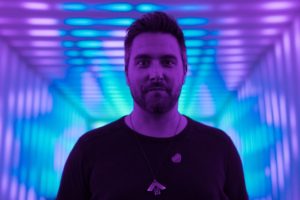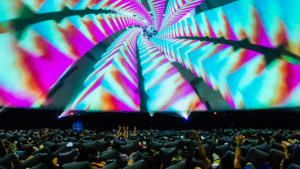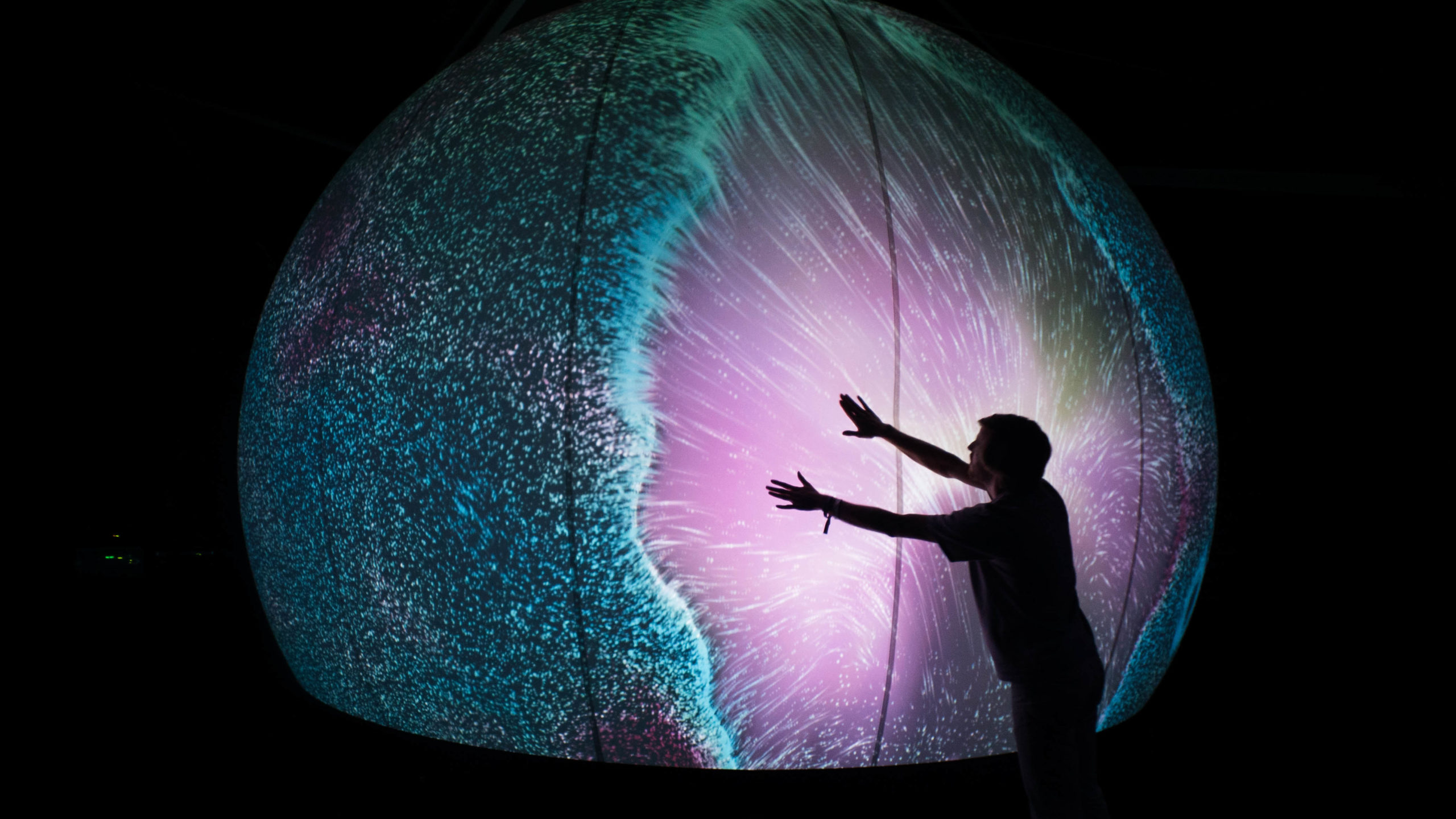
A flash of chartreuse light streams across the concert venue; magenta, neon, and violet beams follow in rapid succession. Raised smartphones try to capture the DJ on stage in the midst of their alchemy. Supersized screens display twisted Dali-esque figures. After the show, fans bubble with excitement by the stage door as the head visual artist steps outside, ready for a barrage of selfies and autographs.
It’s not a common scenario: crowds gathering to meet the person who designed the visual experience of a show instead of the headlining act, but for entrepreneur Justin “J.B.” Bolognino (NU ‘02), it’s not a new experience. As the founder and CEO of META: The Art of Being, Bolognino has spent much of his career seeking out, collaborating with, and supporting the individuals responsible for creating multi-dimensional immersive experiences such as Arcadia Earth and the immensely popular South By Southwest (SXSW) installation #FEED powered by Twitter. He also collaborated with Brooklyn Bowl to bring their brand to life through an award-winning marketing program he created from the ground up and inspired and built the groundbreaking Lab at Panorama alongside some of the best creative technology studios in New York City.
For an industry still in its infancy, the boundaries of what is considered immersive are understandably hazy. However, there is a difference between the utilitarian—spotlights illuminating performers—and the experiential—lighting displays that react to music. Visitors to Arcadia Earth, an in-person art exhibit, don’t simply read blocks of text on a wall while looking at a piece. They interact with environmentally-conscious collaborators from around the world while walking through a virtual reality space. The art projected across SXSW was a visual mashup of real-time Twitter and Instagram posts. At the center of these mixed-medium encounters is the individual, which according to Bolognino, is key.
“What makes for an immersive experience is your participation,” Bolognino says. “An experience isn’t immersive unless it’s participatory. Your behavior, your human energy has to have an effect. There are varying degrees of effect, but even if you’re one person in a twenty-thousand-person crowd you’re having an impact.”
It takes a dedicated team to create a complex immersive experience. Yet early in his career, the niche experts creating these installations were unknown to the general public. Bolognino sought to change that, ensuring that the creative coders, project designers, interactive installation artists, and other visual artists on META’s roster (formerly The Meta Agency) received the credit and compensation they deserved – a precursor to today’s non-fungible tokens (NFTs).
Bolognino is on a mission to further foster the immersive experience industry. His next step? Unreality. The online networking platform serves as a digital cafe where community members can gather to showcase their craft, receive constructive feedback from peers, and search for job opportunities. It’s also a resource for event stakeholders to find the individuals capable of bringing their visions to life.
In addition to the practical problems Unreality looks to solve, the virtual marketplace also seeks to establish a language around immersive experience production. Bolognino recognized that in order for the emerging industry to thrive, people must have a shared lexicon and understanding of the various fields it encompasses. To that end, Bolognino created the Map of Realities which organizes six different forms of reality (CR or conscious, IRL or In Real Life, AR or Augmented, SR or Sonic, URL or online, and VR or Virtual).

On one end of the spectrum, there are traditional realities such as in-person experiences, while the other end is concerned with less tangible digital realities. Keeping track of the relationships between different realities and where they overlap can get tricky, the Map of Realities serves a useful reference point. For example, sitting in the audience at a fashion show is a real, tangible experience, but a heart-to-heart held over video chat is still a real conversation even though it occurs in a virtual space.
The desire for immersive experiences that meld digital and traditional realities is growing exponentially., The understanding that we engage with the world in many ways beyond in-person interactions has also gained traction, especially during the pandemic.
While Bolognino appreciates the relationship between reality and experience, he compares it to Plato’s Perennial Philosophy, that all the world’s traditions and beliefs boil down to one, metaphysical truth. In Bolognino’s case, whether the connection is physical or virtual, the emotional outcome is the same. Bolognino notes his own introduction to these ideas began as a Rhetoric major at Northeastern under the tutelage of now-retired Lecturer Kerry Dugan.
“ Dugan’s philosophy classes, namely his Heidegger classes, were the single biggest life-changing element in my life, up until having kids. To this day, I turn to my journals from that period for inspiration, and they never fail. In three years together, he completely rewrote my reality from the ground up,” says Bolognino.

Bolognino’s experience illustrates the unique interdisciplinary experience CAMD students can have at Northeastern, taking classes across fields or pursuing combined majors to understand art and design in a new way. Unreality is an example of how that interdisciplinary focus can turn into careers focused on solving problems and melding technology and art to create a new language to explore the human experience.
“Unreality is really the culmination of everything I’ve ever done and learned in creating an immersive experience,” Bolognino says. “Now we’re giving those unique tools we’ve developed for the whole world to use. We want to empower the next generation of creatives, producers, and technologists.”
Unreality is currently in its beta-testing phase and will open to the public in early 2022. Immersive experience professionals interested in joining the platform now may request an invite here.


